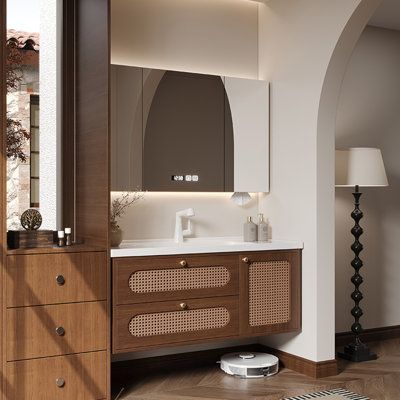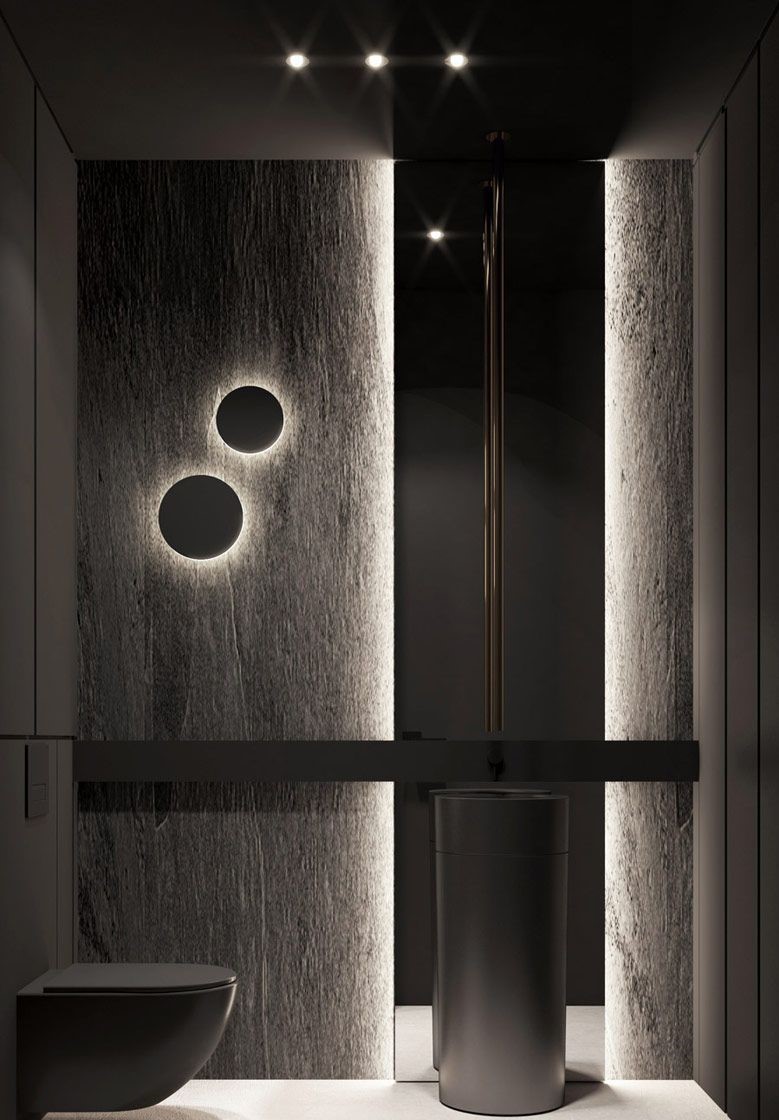No products in the cart.

Embrace the warmth of nature in your bathroom. Discover why wood and rattan vanities are the top trend for 2025, blending Japandi style with modern function for a serene sanctuary.

This image shows a beautifully designed, warm, and inviting bathroom that blends modern functionality with natural, retro-inspired aesthetics.
- Vanity and Sink: The central feature is a stylish floating bathroom vanity. It has a rich, dark wood frame, but the drawer and cabinet fronts are made of light-colored woven rattan or cane webbing, adding a layer of texture and a nod to mid-century modern design. The vanity is topped with a clean, white countertop that features a seamless integrated sink. The faucet is a simple, modern design in a matching white finish.
- Storage and Cabinetry: The vanity is part of a larger, cohesive storage unit. To its left stands a matching tall wooden cabinet with several drawers, offering ample storage space. The hardware on all cabinets consists of simple, dark, circular knobs.
- Mirror and Lighting: Above the vanity is a large, modern mirrored medicine cabinet. It features three panels, with the central mirror having a soft, arched top. The mirror includes integrated backlighting and a small digital display.
- Architecture and Atmosphere: The walls are painted a warm, soft off-white or beige. A prominent, elegant archway on the right side of the frame adds significant architectural character and softness to the space. The flooring is a dark wood, which complements the cabinetry.
- Overall Style: The style is a perfect example of “Japandi” or warm minimalism. It masterfully combines the warmth and natural textures of wood and rattan with the clean lines of modern design, creating a space that is serene, functional, and full of character. The presence of a robotic vacuum cleaner under the floating vanity underscores the blend of modern living with timeless style.
Your Sanctuary’s Heartbeat: The Rise of the Warm, Natural Bathroom Vanity
The era of the cold, clinical bathroom is officially over. As of 2025, the focus has shifted entirely to creating personal sanctuaries—spaces that feel as warm, comfortable, and stylish as any living room. And the single most important element in achieving this is the bathroom vanity. It’s no longer just a place to house a sink; it’s the central piece of furniture that sets the tone. The leading trend? A beautiful fusion of natural materials like wood and rattan with clean, modern design.
The “New Natural”: Why Wood and Rattan are a Perfect Match
The desire for warmth and texture in our homes has led to the resurgence of natural materials, and the bathroom is no exception.
- The Warmth of Wood: A solid wood frame provides a sturdy, timeless foundation. It brings an organic, grounding element into the bathroom that painted or laminate surfaces simply can’t replicate.
- The Texture of Rattan: The re-introduction of woven rattan or cane webbing on cabinet fronts is a masterstroke. It adds a beautiful layer of texture, feels light and airy, and provides a touch of retro or mid-century charm that is incredibly popular in Japandi (Japanese + Scandinavian) and modern organic design.
Balancing Nature with Modern Functionality
A natural look doesn’t mean you have to sacrifice modern convenience. The most successful designs create a perfect balance.
- The Floating Vanity: Mounting the vanity to the wall is a key modern touch. A floating vanity instantly makes a bathroom feel more spacious and open. As a practical bonus, it makes the floor incredibly easy to clean (even for your robotic vacuum!).
- The Seamless Integrated Sink: To contrast the rich texture of the wood and rattan, a crisp, white integrated sink is the ideal choice. The seamless transition from countertop to basin is ultra-clean, minimalist, and hygienic. It provides a smooth, functional surface that perfectly complements the more detailed cabinet fronts.
- Smart, Cohesive Storage: A great vanity is part of a larger storage strategy. Look for designs that are part of a modular system, allowing you to add tall cabinets or other units for a fully built-in, custom look. Pairing this with a modern, illuminated medicine cabinet ensures every item has its place.
Conclusion: Crafting Your Comfortable Space
The perfect bathroom vanity for 2025 is all about balance. It’s the harmony between the organic warmth of wood and rattan and the clean functionality of a floating design and an integrated sink. By choosing a vanity that doubles as a beautiful piece of furniture, you are investing in the heart of your bathroom, creating a serene and stylish sanctuary you’ll love for years to come.
相关产品
-
Elegance Meets Comfort: OLEARY Artificial Stone Freestanding Bathtub
$2,088.90 – $2,968.90 -
Illuminate Your Bathroom: High-Quality Glossy Freestanding Bathtub
$2,198.90 – $3,188.90 -
Immersive Relaxation: OLEARY Deep Soaking Bathtubs for Ultimate Comfort
$1,538.90 -
Modern Round Stone Resin Freestanding Bathtub | Premium Custom Design, Luxurious Soaking Experience
$1,758.90 – $2,968.90
The Monolith: How the Freestanding Pedestal Sink Commands the Modern Bathroom
How the Freestanding Pedestal Sink Commands the Modern Bathroom
Meta Description: As of 2025, the freestanding pedestal sink is a minimalist monolith. Discover how these sculptural sinks, especially in dark tones, create bold, atmospheric bathroom statements.

This image portrays a dramatic, moody, and ultra-minimalist bathroom or powder room, where lighting and texture are the main characters.
- Focal Point: The centerpiece is a sleek, freestanding pedestal sink. It has a pure, cylindrical, monolithic form and is finished in a matte dark grey or black. It stands as a bold, sculptural object in the center of the composition.
- Lighting Design: The lighting is the most critical element of the design. Dramatic, vertical LED strips are concealed behind two large wall panels, casting a soft glow that grazes the textured surfaces and creates an illusion of floating panels. On the left panel, two circular, backlit wall sconces are mounted, appearing like minimalist celestial bodies. A few small downlights on the ceiling provide focused illumination from above.
- Walls and Materials: The primary walls are clad in a dark, heavily textured material, likely a natural rough-hewn stone or a tactile wood finish. The deep texture catches the light beautifully, adding depth and a raw, organic quality to the space.
- Mirror and Fixtures: A tall, narrow, frameless mirror is recessed between the two textured panels, creating a reflective central column. Behind the sink, a tall, slender floor-mounted faucet in a dark metallic finish rises elegantly. To the far left, a wall-hung toilet in a matching matte black finish maintains the minimalist and clean aesthetic. A thin, horizontal black shelf runs across the composition, unifying the elements.
- Overall Atmosphere: The style is a masterclass in “moody minimalism.” It uses a dark, monochromatic color palette, strong vertical lines, and layered lighting to create a space that feels intimate, sophisticated, and highly atmospheric, almost like a contemporary art installation.
Beyond White & Bright: The Rise of the Moody Minimalist Bathroom
For years, minimalism in the bathroom meant white tiles, chrome fixtures, and abundant light. But as we move through 2025, a new, more atmospheric interpretation of minimalism has taken center stage. It’s about depth, texture, and emotion, and its hero is the monolithic freestanding pedestal sink. This is not just a fixture; it’s a sculptural statement that anchors a space, proving that minimalism can be both powerful and deeply sophisticated.
The Pedestal Sink as a Monolithic Sculpture
The contemporary pedestal sink bears little resemblance to its delicate porcelain ancestors. Today’s most impactful designs are defined by their bold, simple, and solid forms.
- Purity of Form: The modern pedestal sink is a study in pure geometry. Think solid cylinders, cubes, and clean rectangular columns. This “monolithic” approach gives the sink a substantial, architectural presence that feels both timeless and forward-thinking.
- The Power of Dark, Matte Finishes: Moving away from gloss white, these sinks are now being crafted in deep, tactile materials. Matte black, charcoal grey, and even dark stone finishes absorb light in a unique way, adding a sense of quiet luxury and turning the sink into a commanding silhouette.
The Secret is Light: Designing Around a Statement Sink
A dark, monolithic sink truly comes to life when paired with a masterful lighting scheme. The goal is not to flood the space with light, but to “paint” with it.
- Grazing with Backlights: The most dramatic technique is to use vertical LED strips to wash textured walls with light. This “grazing” effect, as seen in the image, highlights every imperfection and line in materials like rough stone or wood, creating immense depth and visual interest.
- Lighting as Art: Treat your lights as sculptures. The simple, backlit circular sconces in the example are not just for illumination; they are a key part of the composition, balancing the strong vertical lines of the sink and lighting strips.
- An Elegant Faucet: A freestanding sink calls for a complementary faucet. A tall, floor-mounted or wall-mounted tap in a simple, elegant form and a matching dark or metallic finish completes the look without adding clutter.
Crafting the Complete Look
To achieve this moody, minimalist aesthetic, focus on a cohesive material and color palette.
- Embrace Texture: In a monochromatic space, texture is everything. Pair the smooth surface of your sink with richly textured walls to prevent the design from feeling flat.
- Commit to the Palette: Don’t be afraid of the dark. A palette of deep greys, blacks, and charcoals for the sink, toilet, and walls creates an immersive, sophisticated experience.
- Use Reflection Strategically: A tall, narrow mirror can add depth and reflect your carefully planned lighting without overwhelming the serene, intimate atmosphere.
Conclusion
The freestanding pedestal sink has been reborn as a powerful tool for architectural expression. It is the centerpiece of the modern, moody bathroom—a space designed not just for function, but for feeling. By embracing a dark palette, focusing on texture, and mastering the art of lighting, you can use this simple, sculptural form to create a bathroom that is truly a work of art.


























Add comment